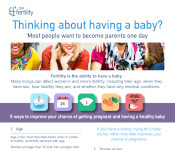Endometriosis affects 10 to 15 percent of all women of reproductive age and 70 percent of women with chronic pelvic pain. It occurs when cells, similar to those that line the uterus, grow outside the uterus. This can cause severe pelvic pain and fertility problems.
About 30 percent of women with endometriosis have fertility problems.
It is important to remember that not all women with endometriosis are infertile. Many women have children without difficulty; have already had children before they are diagnosed; or over time, eventually have a successful pregnancy.
-
The facts
In moderate to severe forms of endometriosis, scarring of the ovaries may interfere with ovulation. Scarring may also damage or block the fallopian tubes so that eggs can’t travel to the uterus and sperm can’t reach the egg. A fertilised egg (embryo) may have trouble implanting if the uterus is damaged by endometriosis.
In mild endometriosis, there is no obvious reason why infertility occurs. It is thought that there may be some chemicals released from the endometriosis cells that interfere with the ability to get pregnant or affect the development of the embryo.
-
Symptoms
- painful periods that restrict your normal activity
- pelvic, lower back or leg pain
- excessive tiredness or fatigue
- pain when using your bowel or urinating
- constipation or feeling bloated.
Women with endometriosis often are not diagnosed for years after they first start having symptoms. This is because it can be difficult to diagnose, as the symptoms vary between women and can change over time. Recognising the symptoms and talking to your doctor can help you get treatment early. This can help reduce the severity of endometriosis.
-
The good news
There are options to help women manage their pain, including pain medications, hormone treatment and different types of surgery. Some women also benefit from natural therapies. There is no direct evidence that lifestyle affects endometriosis but regular exercise, nutritious food, getting enough sleep and reducing stress when possible can help you manage the symptoms.
-
What you can do
If you suspect that you have endometriosis see your GP for advice. Early diagnosis is important so that you can get the help you need to manage the symptoms of endometriosis.
If you have been diagnosed with endometriosis and have trouble conceiving, see a fertility specialist to discuss treatment options.
-
References
- Facchin, F., et al. (2015). Impact of endometriosis on quality of life and mental health: pelvic pain makes the difference. Journal of Psychosomatic Obstetrics and Gynaecology, 36(4), 135-141. doi: 10.3109/0167482X.2015.1074173.
-
Hart, R. J. (2016). Physiological Aspects of Female Fertility: Role of the Environment, Modern Lifestyle, and Genetics. Physiological Reviews, 96(3), 873-909. doi: 10.1152/physrev.00023.2015.
Hickey, M., et al. (2014). Endometriosis. BMJ : British Medical Journal, 348. doi: 10.1136/bmj.g1752.
Lalani, S., et al. (2018). Endometriosis and adverse maternal, fetal and neonatal outcomes, a systematic review and meta-analysis. Human Reproduction, 33(10), 1854-1865. doi: 10.1093/humrep/dey269.
Leeners, B., et al. (2018). The effect of pregnancy on endometriosis—facts or fiction? Human Reproduction Update. doi: 10.1093/humupd/dmy004.
Marinho, et al. (2018). Quality of Life in Women with Endometriosis: An Integrative Review. Journal of Women's Health, 27(3), 399-408.
Parasar, P., et al. (2017). Endometriosis: Epidemiology, Diagnosis and Clinical Management. Current obstetrics and gynecology reports, 6(1), 34-41. doi: 10.1007/s13669-017-0187-1.
Zullo, F., et al. (2017). Endometriosis and obstetrics complications: a systematic review and meta-analysis. Fertility and Sterility, 108(4), 667-672.e665. https://doi.org/10.1016/j.fertnstert.2017.07.019.



